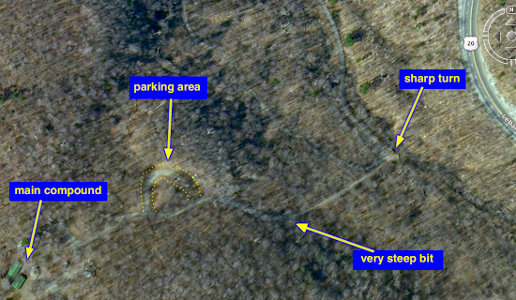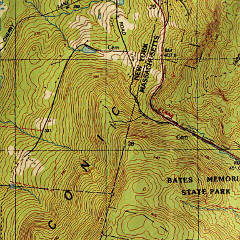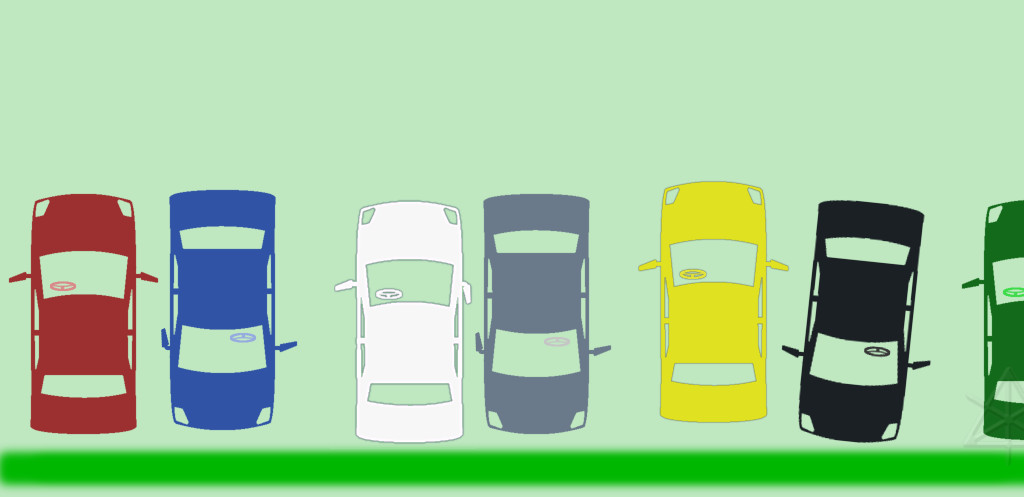|
The darker green band is the woodsy perimeter of the parking area.
The basic idea is to alternate directions, and get the right-hand
[passenger] sides of the vehicles as close together as possible and
leave only enough room on the left side for a driver to swing a door
open far enough to safely get in and out. Find the end of the row on
either side and follow the model to add yourself as the new end. Be
patient if others ahead of you are still working their way in. In the
narrower parts of the clearing near the middle, it may take a little
back-and-forth shuffling to get lined up right.
-
Useful mnemonic: if you come along and see the Butt of a car
you'll be parking next to, you'll want to Back in next to it.
See Headlights? Then you'll go Head-in.
-
It is useful to know how to back up using your external side mirrors to
align the approach angle and rear of the car. You can see exactly how close
you are on either side, just like truckers do when slotting into a tight
loading dock. This skill comes in *really* handy if you have to back down
the steep part of the road. Practice beforehand in a quiet area, and do
what truckers call "GOAL" when you aren't sure of your dimensions or
proximity -- Get Out And Look. You can safely get very close to another
vehicle without contacting it if you move carefully.
-
Fold the passenger-side mirror if possible, as shown on the blue, white, and
grey cars. It gains an easy six to twelve inches, and it matters. Yes,
that sounds like it also conflicts with using mirrors to back -- but if
the back-in is already lined up correctly, nice and close with the wheels
straight, the mirror can get folded in just before the final move past the
other vehicle. Have a spotter help if you aren't sure at that point.
-
If the mirrors can't fold, you can do a slight angle-in trick like the
black car to still put the right-sides closer together and leave more exit
room. The tail of the black car and nose of the green one are closer
together, but there's more room where the drivers' doors are. If any of
the nose-in cars here back straight out, they won't interlace mirrors, and
sometimes vehicles of different heights can pass mirrors right over each
other safely. Also remember that when going head-in, it may be possible to
steer the front end of the car over a slightly curving path to clear another
mirror with yours, but still wind up with your front end closer on the
passenger side. In general, move SLOWLY and watch for any interference.
-
If you take a passenger with you when going to park, they might want to get
out just before making the final move as it's easier than having them clamber
over the hump and out the driver's side.
-
As the overall angle changes around the curve of the parking area, adaptations
obviously need to be made. Try to go straight toward the edge wherever you
are -- don't diagonal-in because that will lose a lot of space a couple of
cars later. On the inside arc, the corners of the cars toward the weeds can
almost touch. On the outer, longer sweep, the corners of the cars nearest
the central path can be closer together but leave just enough room to squeeze
past when walking so you can get *to* your vehicle! Above all, make sure the
car(s) next to you will still be able to pull out without interference. Tight
clearance is okay, as long as it's still *clearance*.
-
Do not spin wheels and rip up the grass or gravel. Feather the accelerator
gently to move. If conditions are wet and traction is poor, line up
and take a small run at where you need to be but ONLY if there's safe
room to do so including any rocking that uneven ground may produce in
the process. Or, just don't go as far in. But in general, pushing as
far in toward the parking area perimeter as possible is helpful, especially
on the outer arc.
-
When you place your ID sign, make sure it is OUTSIDE of any sun-shield
you install in the window so it's still externally visible.
And again, don't be afraid to ask for help if you aren't comfortable
maneuvering your own vehicle at close quarters. Some people will be on
duty to help with parking, but not to micromanage it. Our best efficiency
depends on your good sense.
And like the webpage says -- CARPOOL!
[Back to main picture page]
|


